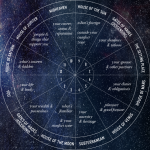Each culture has its own unique way of keeping time. A student of Vedic astrology reading the classic texts should understand the Vedic measures of time as well as the calendars used. The terms and measures used are interwoven with the mythology of Hinduism and are also mathematically defined.
The terms that are used in Vedic astrology with relation to time are not commonly used in our day to day lives. However traditional and regional Ephemeris or Panchang still use these terms. Reading up on the terms and units used in classic texts of astrology is a must for the student of astrology.
Samvatsara
Traditional calendars define 60 distinct Samvatsaras that follow each other in order. When the cycle of 60 years is over it restarts again. So, each year has a Samvatsara name. Of these 60 Samvatsaras, Lord Brahma rules 20, Lord Vishnu rules 20 and Lord Shiva also rules 20. These sets of 20 years is a Beesee or Vimshatika. The start of a Samvatsara year is at sunrise on the first lunar day of the month of Chaitra.

Vikram Era Or Vikram Samvat
One of the traditional Hindu calendars is the Vikram calendar. It is named after King Vikramaditya. It is also the official calendar of Nepal. The Vikram calendar became popular in the 9th century and is also known as the Krita or Malava calendar. The calendar starts from the year 57 BC and is believed to have commemorated the defeat of the Sakas by King Vikramaditya. It is based on both the Sun and the Moon.
A Vikram Samvat year has 354 days in the year and has 12 lunar months. The month is divided based on the waxing and waning phases of the Moon. The 15 Shukla Paksha days are the growing days from new to full moon and the Krishna Paksha in the waxing phase from new moon to the full moon. Since the calendar month is lunar it starts and ends in the middle of the Gregorian month. The year begins on the first lunar day or Tithi of the Chaitra Shukla.
Vikram Samvat Month Relating To The Gregorian Calendar Month
- Chaitra March to April
- Baishakh April to May
- Jestha May to June
- Ashadh June to July
- Shravan July to August
- Bhadra August to September
- Ashwin September to October
- Kartik October to November
- Mangsir November to December
- Poush December to January
- Magh January to February
- Falgun February to March

Astrologers practising mundane astrology cast the chart for the time and date of the first day of the month of Chaitra. This is called the Samvatsara chart and it is useful in studying the astrological indications for the new year.
Saka Era
This is another ancient calendar popularly used. It is also the official calendar of India. It starts at 78 AD. The King Shalivanhana of the Shatavahana dynasty started this calendar. The year in this calendar has 365 days and 12 months which is very similar to the Gregorian Calendar. Saka Samvat or year starts with Chaitra which begins around March 21 or 22 when the Sun enters Aries.
Saka Samvat Month Relating To The Gregorian Calendar Month
- Chaitra March 21 to April 20
- Vaishakha April 21 to May 21
- Jyeshtha May 22 to June 21
- Ashadha June 22 to July 22
- Shravana July 23 to August 22
- Bhadra August 22 to September 22
- Ashwin September 23 to October 22
- Kartika October 23 to November 21
- Agrahayana November 22 to December 21
- Pausha December 22 to January 20
- Magha January 21 to February 19
- Phalguna February 20 to March 20/21
Seasons
India has seasons that do not correspond to the four seasons of the western world. The spring season is Basant, Summer is Greeham, Rainy is Varsha, Autumn is Sharad, Dewy is Hemanth and Winter is Shirshira.

Sankranti
A Sankranti is the transit of the Sun from one Rashi to the next. It happens in the middle of every Gregorian month.
Aadhik Maas
Since the traditional year is 354 days long there can be a misalignment with the solar calendar if not adjusted. For this reason, around once every 32.5 months an extra month Adhika Maas or Malmas is added. The solar year that has an Adhik Maas added is a Luni-Solar Year. This Adhik Maas will not have a Sankranti or Sun transit day in it. The number of Amavasya in this year will be more than the number of Sankrantis.
Kshay Maas
Sometimes a lunar month can have two Sankrantis. This is very rare. This month is then a lesser or Kshaya Maas.

The Sun: Uttarayana and Dakshinayana
The apparent movement of the sun in the Northern direction is Uttarayana and the apparent southern movement is Dakshinayana. Another term for Uttarayana is Saumayayana and an alternate term for Dakshinayana is Yamyayana. Uttarayana begins when the Sun enters Capricorn which is also Makara Sankranti. Then, when the Sun enters Cancer it is Dakshinayana which is the Southern movement.
Tithi
A Tithi is a lunar day. It is the longitudinal angle the Moon has travelled from the Sun. Every 12 degrees that the Moon is away from the Sun is one Tithi. A Tithi has no fixed duration and so can be anywhere from 19 to 23 hours long. Each Tithi has a special name, ruling deity and meaning and also auspiciousness. A lunar month has a total of 30 Tithis. The most well known are Amavasya as well as Poornima. The intervening 14 waxing Tithis are Shukla Paksha and the 14 waning Tithis are Krishna Paksha.
The names of the Tithis are
- Pratipad
- Dwitiya
- Tritiya
- Chaturthi
- Panchami
- Shashti
- Saptami
- Ashtami
- Navami
- Dasami
- Ekadasi
- Dwadashi
- Trayodasi
- Chaturdasi
- Purnima
- Amavasya

Aadhik Tithi
The start of a day is calculated as the time the sun rises. However, a Tithi or lunar day is calculated from the distance on the Moon from the Sun. So, the start of a Tithi may not necessarily coincide with the start of the day. When the same Tithi occurs on two consecutive sunrises it is called an Adhik Tithi.
Kshay Tithi
Sometimes it so happens that three Tithis pass from one sunrise to the next and the middle Tithi gets cancelled. This is also called Kshay Tithi.
Muhurta And Panchang
As per tradition, when any important activity is planned, an astrologer is consulted to select a Muhurta. This is basically a 48-minute time slot that is analysed in five different aspects.
These five aspects are the
- Vara or weekday
- Tithi also lunar day
- Moon’s nakshatra placement
- Yoga or the angular difference and relationship between the Sun and the Moon
- Karana which is a half of the Tithi
Tithi is very important. It is one of the Vedic measures of time that determines what kind of task or activity the day is suitable for. Both auspicious and inauspicious Tithis are used for different kinds of work.

Vedic Measures Of Time: Units
There are also other terms for time from the smallest to the longest
A Krati is 34,000th of a second. The smallest immeasurable unit of time is a Truti. It is the time it takes to tear a lotus petal.
100 Trutis make 1 Tatpal/Lub
30 Tatpals/Lub make 1 Nimesha (which is the time that it takes to blink)
18 Nimeshas make 1 Kastha
30 Kaasthas make 1 Kaala (8/5 of a minute)

further, 30 Kaalas make 1 Muhurta
30 Muhurtas is one day and night which is 24 hours
27 Nimesh make 1 Guru Akshar
10 Guru Akshar Make 1 Pran
6 Pran Vighatika make 1 Ghatika or Dand
60 Ghati make 1 day and night
Another way to relate the different units of time is
5 Ghatis make 2 hours
5 Vighati make 2 minutes













